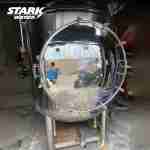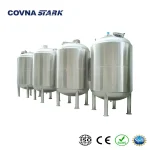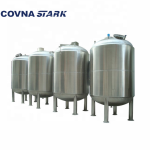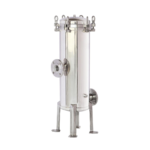In industrial water treatment, few components are as foundational—and as overlooked—as the mechanical filter. When crafted from stainless steel, this filtration system becomes a long-lasting, corrosion-resistant backbone of pre-treatment processes. Whether you're operating a reverse osmosis (RO) system, protecting sensitive equipment, or ensuring water purity for production, a stainless steel mechanical filter provides the essential first line of defense.
What Is a Mechanical Water Filter?
A mechanical filter physically removes suspended solids, sand, silt, rust, and other particulate matter from raw or pre-treated water. Unlike chemical filters or biological methods, mechanical filtration relies solely on physical interception. This makes it ideal as a pre-treatment step in systems such as RO, UF, or ion exchange, where membrane protection and equipment longevity are critical.
In a typical industrial mechanical filter, water flows through a cylindrical tank—often vertical—filled with filter media or cartridges. Contaminants are trapped as the water passes through, while clean water exits toward downstream processes.
Why Choose Stainless Steel as the Filter Material?
While carbon steel and FRP are common, stainless steel (typically SUS304 or SUS316L) stands out due to:
- High corrosion resistance: Suitable for seawater, brackish water, and chemical-rich sources.
- Longer service life: Durable under high pressure, temperature, and aggressive cleaning.
- Hygienic and food-grade: Suitable for applications in F&B, pharmaceuticals, and ultrapure water systems.
- Low maintenance: Less prone to internal coating failure or biological fouling.
Learn more about our stainless steel filtration solutions here: STARK Stainless Steel Mechanical Filter
Core Components and Working Principle
- Filter housing: Made from high-grade stainless steel, designed to withstand high pressures.
- Inlet/outlet ports: Usually flange-type, customizable per flow requirement.
- Internal filter elements: Could include wedge wire screens, mesh cartridges, or sand media depending on system type.
- Drain/vent ports: For backwashing or air release.
- Pressure gauges and differential indicators: Used to monitor clogging and plan maintenance.
When raw water enters the vessel, it passes through the internal media or screen. Suspended particles are captured, and filtered water continues downstream. The system may be equipped with automatic or manual flushing mechanisms for cleaning.
Key Applications in Water Treatment Systems
- RO Pre-filtration: Prevents fouling and damage to expensive membranes.
- Boiler feed water: Removes particulates to ensure steam quality and system protection.
- Process water for manufacturing: Ensures stable water quality in F&B, textile, electronics, and pharmaceutical industries.
- Effluent polishing: Captures residual solids before discharge or reuse.
How to Select the Right Stainless Steel Mechanical Filter
When choosing a mechanical filter, consider the following technical parameters:
- Flow rate: Typically ranges from 1 m³/h to 200 m³/h.
- Particle load: Higher turbidity requires larger surface area or multiple units.
- Inlet pressure and pressure drop: Monitor to avoid upstream pump stress.
- Automation level: Choose between manual, semi-auto, or automatic backwash systems.
- Material grade: 304 is suitable for general use; 316L is preferred for seawater or aggressive media.
Maintenance and Longevity Tips
- Conduct regular pressure differential checks to detect clogging.
- Clean or replace internal cartridges or screens per schedule.
- Ensure periodic sanitization if used in hygienic applications.
- Inspect welds and seals for corrosion or fatigue annually.
Case Highlight: Mechanical Filter in a Southeast Asia RO Plant
A food processing facility in Malaysia installed two parallel STARK stainless steel mechanical filters upstream of its 40 m³/h RO system. The filters removed suspended particles and protected membranes, reducing fouling incidents by 70% and extending membrane life by over 18 months. The system uses semi-automated backwash and requires only weekly supervision—ideal for regions with limited skilled labor.
Conclusion: The Unsung Hero of Pre-treatment Systems
The stainless steel mechanical filter is often underestimated, yet it plays a foundational role in ensuring the performance, reliability, and longevity of downstream water treatment systems. Its robust construction, versatility, and efficiency make it a wise investment for industries across Southeast Asia and beyond.
If you're considering upgrading your pre-treatment system or need expert advice on sizing and customization, don't hesitate to contact the STARK Water team. We're here to help you build sustainable, efficient, and future-proof water treatment infrastructure.





